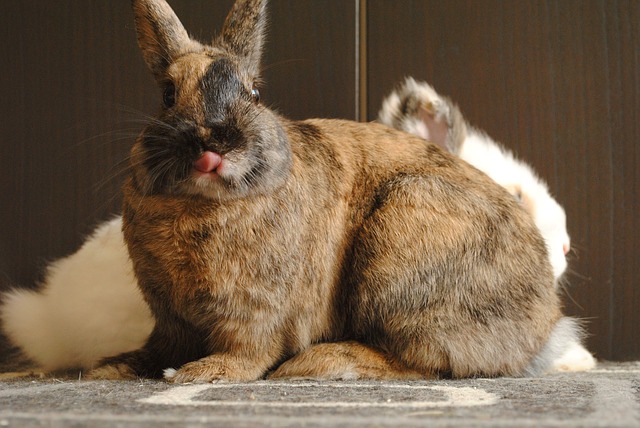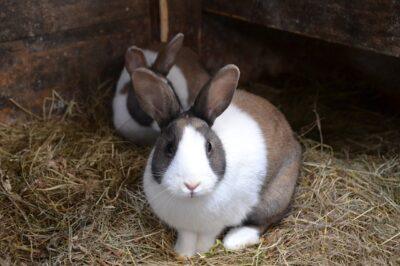
When my family decided to raise meat rabbits, we checked out several books about rabbit raising. They all urged readers to feed scientifically formulated rabbit pellets rather than trying to grow and mix their own feed.
This didn’t make sense to us, for several reasons.
We were interested in having more control over our feeding program as well as our breeding program. We wanted to know what our rabbits were actually eating, and we wanted to grow as much of it as possible.
We were trying to move away from GMOs. Alfalfa is one of the major ingredients in rabbit pellets, and most commercially produced alfalfa in the U.S. is genetically modified.
We wanted to provide our rabbits with fresh food. Pellets contain foodstuffs that have been ground mixed, cooked and then left to sit at the mill or the feed store for an unknown period of time.
We saw some warnings about pelleted feeds on some of the online forums, where small farmers shared their experiences. Some reported trouble with weaning enteritis as kits switched from mother’s milk to pellets. Others reported getting bad batches of feed that killed adult rabbits as well as kits.
A Look at History
Historically, of course, rabbits were not raised on pellets. Some grain feeding was traditional, but even that was optional. In Britain during World War II when grain was scarce, a study showed that rabbits could be raised to market weight on a diet of only sow thistles and cooked potatoes. That gave us hope that a diet based on homegrown and gathered greens and roots was possible.
Then we found the forums at RabbitTalk.com The founder of that forum had taken time to work out a natural diet for her meat rabbits, and many other forum participants had devised different natural diets that suited their areas and home conditions. With their help, we learned to feed our own rabbits with locally available ingredients.
We bought pellet-raised rabbits — two New Zealand White does and one Silver Fox buck — and switched them to natural feed over about eight weeks. Our buck and one of our does thrived on the new diet. Our other doe began to have smaller litters—we’re not sure whether that was a feeding problem or an age problem. We raised those kits on our diet.
Learn Everything You Don’t Know In “The Big Book Of Off The Grid Secrets”!
Our rabbit diet is cheap, under our control, and (we think) healthy. It also may yield a slower growth rate than straight pellet feeding. Some pellet feeders report having kits up to 4.5-5 pounds in eight weeks. It takes us 12-15 weeks. We’re satisfied with that. We’ve never had weaning enteritis, and over the last two years, as we’ve kept selecting and breeding rabbits who thrive on our diet, our kit growth rates have steadily improved.
All-Natural Ingredients
Rabbit food needs to provide protein, energy, fiber, vitamins and minerals.

Protein is especially important for growing kits and nursing mothers. In most pelleted rabbit feeds, and in some natural diets, protein comes mainly from alfalfa. Other legumes such as clovers, birdsfoot trefoil (Lotus corniculatus), vetch (Vicia spp — don’t feed the seed pods) and pea and bean vines (feed stems and leaves, not seeds) also have high protein content.
Many other wild-growing weeds are also high in protein. Willow, mulberry (Morus spp), dandelions, chicory (Cichorium intybus), lamb’s quarters (Chenopodium album), yellow dock and burdock (Rumex crispus and Arctium spp — both should be fed only when very young), and comfrey (Symphytum spp — best fed wilted — our rabbits don’t tend to eat it really fresh) are particularly high in protein. Most other rabbit-safe green plants have decent levels of protein when they are young and growing vigorously. In addition to the plants listed above, we feed weeds including grass, redroot pigweed (Amaranthus retroflexus), prickly lettuce (Lactuca serriola), chickweed (Stellaria media) and plantain (Plantago spp), and garden extras including parsley, borage, kale, chard and the tops of turnips, carrots, radishes and parsnips.
Fiber keeps the rabbits’ digestive systems functioning properly. Free-choice hay is our major fiber source, supplemented by twigs and brambles, including willow, mulberry, apple, sumac, blackberry and raspberry.
Vitamins and minerals can be offered in two ways. We still put pieces of purchased mineral salt blocks in our rabbit cages. We also feed a wide variety of green plants; the weeds listed above provide different vitamins and minerals.
Energy (calorie) requirements vary depending on the rabbit’s life stage and the weather. During the growing season, our adult rabbits get all they need from hay, twigs and green plants, except when they’re nursing their young. Nursing mothers and growing kits, and all rabbits in winter, get extra energy supplements in the form of whole grains (dry whole oats or whole wheat in summer, sprouted wheat in winter) and root vegetables (raw carrots, turnips, radishes and parsnips, and cooked potatoes; never feed raw potatoes). Nursing mothers also get small amounts of black-oil sunflower seeds.
Some feeds also have medicinal value. Plantain and blackberry can help settle upset digestions. Raspberry is good for does during late pregnancy and shortly after birth. Chives are not recommended as a frequent feed but they have de-worming and antibiotic properties.
Mixing, Measuring and Safety
If you feed your rabbits whole food, you can let them choose between different types of food and balance their own diets, up to a certain point. Hay always should be available. Fresh greens are generally safe to feed in quantity. Rabbits will pig out on high-calorie foods if you let them. However, it’s easy to tell whether your rabbits are overfed, underfed or just about right. When they’re sitting in a normal arch-backed position, feel their spines. If the backbone feels sharp, the rabbit is thin. If you have to prod hard to find the backbone, the rabbit is fat. (Or, depending on the breed and season, the rabbit has a heavy winter coat.) If you can feel the backbone but it doesn’t feel sharp, you probably have a well-nourished rabbit.
It’s best to introduce any new food in small quantities; rapid changes in feeding can lead to indigestion. Don’t gather moldy plants or store cut green plants in a way that lets them get moldy. We’ve read that rabbits are very sensitive to mold. We’ve avoided putting that to the test.
What do you feed your rabbits? What has worked well for you and what has caused problems? Share your suggestions in the section below:
Discover The Secret To Saving Thousands At The Grocery Store. Read More Here.









